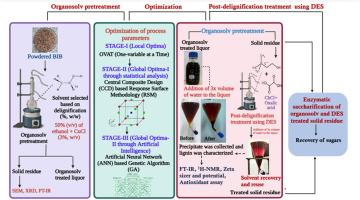有机溶剂- des双相脱木质素高效分离香蕉花序苞片木质素的协同CCD-ANN优化
IF 3.8
Q2 BIOTECHNOLOGY & APPLIED MICROBIOLOGY
引用次数: 0
摘要
将木质纤维素生物质有效地分离成其主要成分(纤维素、半纤维素和木质素)对可持续生物炼制的进步至关重要。本研究通过综合预处理策略,探索了香蕉花序苞片(BIB)这一未被充分利用的农业废弃物作为潜在的原料。该工艺将有机溶剂预处理与随后的基于深度共熔溶剂(DES)的脱木质素后步骤相结合,以增强脱木质素并提高纤维素的可及性。首先,采用单变量-一次(OVAT)方法对有机溶剂工艺参数进行优化,然后通过基于中心复合设计(CCD)的响应面法(RSM)和结合遗传算法(ANN-GA)的人工神经网络进一步优化。优化后的ANN-GA模型在料液比为1:12 (w/v)、温度为75℃、时间为120 min的条件下,预测并实现了64.77±0.32% (w/w)的脱木质素。采用红外光谱(FT-IR)、核磁共振光谱(1H NMR)、粒径分析和抗氧化活性等方法对有机溶剂和DES液中提取的木质素组分进行表征。此外,经预处理的生物质酶糖化处理后,有机溶剂处理和des处理的固体残渣中可发酵糖的转化率分别为41.95±0.10% (w/w)和57.97±0.21% (w/w),表明纤维素的消化率有所提高。此外,本研究中使用的溶剂经过三次连续处理循环再利用,乙醇回收率为85%,DES回收率为83.33%,提高了该工艺的环境和经济可行性。因此,本研究强调了BIB作为现代生物精炼厂生物催化应用和木质素增值的可行、可持续原料的潜力。本文章由计算机程序翻译,如有差异,请以英文原文为准。

Synergistic CCD-ANN optimization of organosolv–DES biphasic delignification for high-yield lignin isolation from banana inflorescence bract
The efficient fractionation of lignocellulosic biomass into its primary constituents (cellulose, hemicellulose, and lignin) is pivotal for the advancement of sustainable biorefineries. In this study, banana inflorescence bract (BIB), an underutilized agro-waste was explored as a potential feedstock through an integrated pretreatment strategy. The process combined organosolv pretreatment with a subsequent deep eutectic solvent (DES)-based post-delignification step to enhance delignification and improve cellulose accessibility. Initially, the organosolv process parameters were optimized using a one-variable-at-a-time (OVAT) approach and further refined through central composite design (CCD)-based response surface methodology (RSM) and an artificial neural network integrated with a genetic algorithm (ANN-GA). The optimized ANN-GA model predicted and achieved a delignification of 64.77 ± 0.32 % (w/w) under the conditions of 1:12 (w/v) solid-to-liquid ratio at 75 °C for 120 min. To recover residual lignin, DES-based post-delignification treatment was conducted. The lignin fractions extracted from both organosolv and DES liquors were characterized using FT-IR, 1H NMR spectroscopy, particle size analysis, and antioxidant activity assays. Furthermore, enzymatic saccharification of the pretreated biomass yielded 41.95 ± 0.10 % (w/w) and 57.97 ± 0.21 % (w/w) of fermentable sugars from organosolv-treated and DES-treated solid residues respectively, indicating improved cellulose digestibility. In addition, the solvents used in this study were recycled and reused for three successive treatment cycles, achieving a recovery of 85 % for ethanol and 83.33 % for DES that could enhance the environmental and economic feasibility of the process. Hence, this study underscores the potential of BIB as a viable, sustainable feedstock for biocatalytic applications and lignin valorization in modern biorefineries.
求助全文
通过发布文献求助,成功后即可免费获取论文全文。
去求助
来源期刊

Biocatalysis and agricultural biotechnology
Agricultural and Biological Sciences-Agronomy and Crop Science
CiteScore
7.70
自引率
2.50%
发文量
308
审稿时长
48 days
期刊介绍:
Biocatalysis and Agricultural Biotechnology is the official journal of the International Society of Biocatalysis and Agricultural Biotechnology (ISBAB). The journal publishes high quality articles especially in the science and technology of biocatalysis, bioprocesses, agricultural biotechnology, biomedical biotechnology, and, if appropriate, from other related areas of biotechnology. The journal will publish peer-reviewed basic and applied research papers, authoritative reviews, and feature articles. The scope of the journal encompasses the research, industrial, and commercial aspects of biotechnology, including the areas of: biocatalysis; bioprocesses; food and agriculture; genetic engineering; molecular biology; healthcare and pharmaceuticals; biofuels; genomics; nanotechnology; environment and biodiversity; and bioremediation.
 求助内容:
求助内容: 应助结果提醒方式:
应助结果提醒方式:


